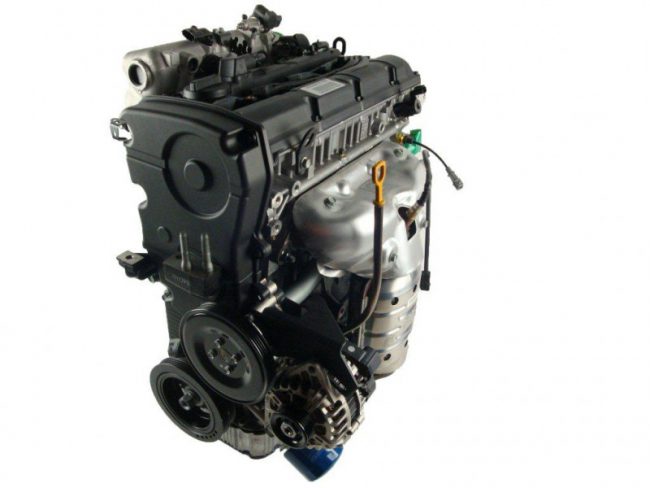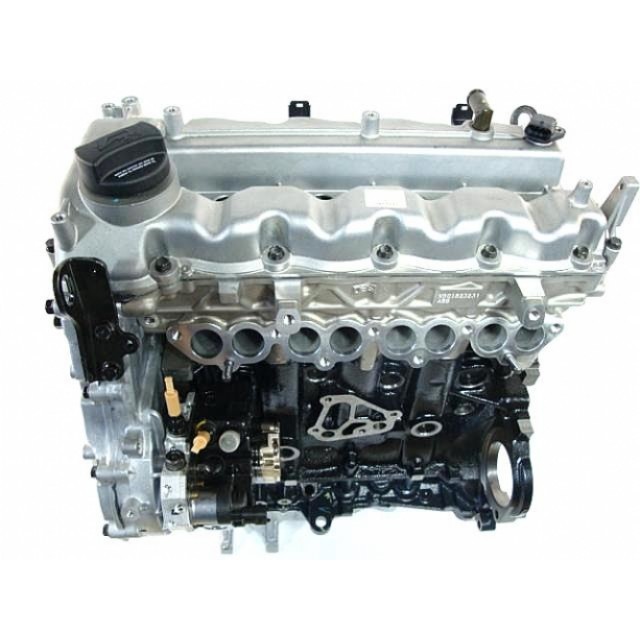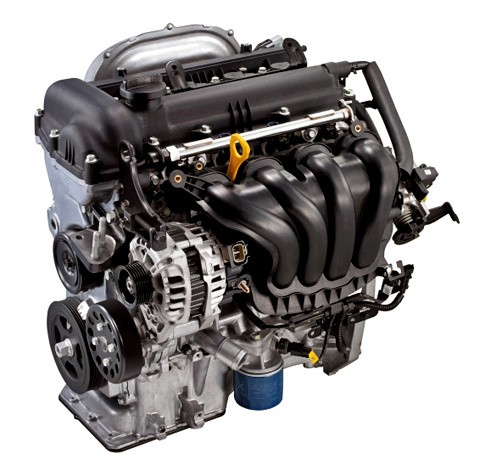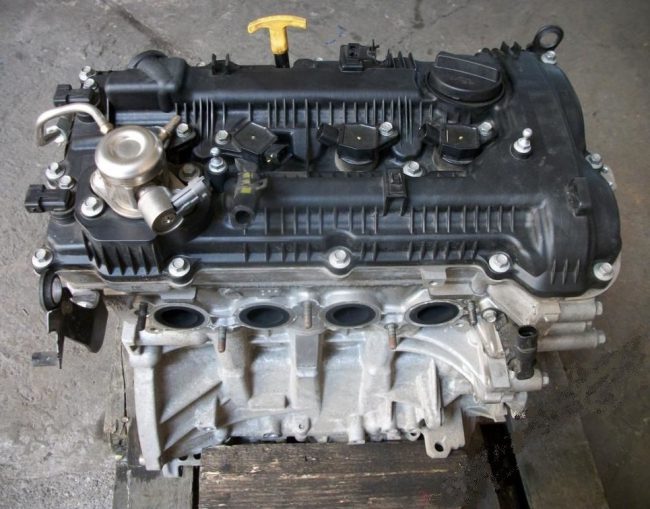
Kia Cerato engines
Content
Kia Cerato is a C-class car of the Korean brand, created on the same base as the Elantra. Most of the cars were produced in a sedan body.
In the first generation, a hatchback was an alternative to it, starting from the second, a coupe body appeared.
Cerato I generation engines
The first generation of Kia Cerato was released in 2004. On the Russian market, the model was available with three power plants: a 1,5 liter diesel engine, 1,6 and 2,0 liter gasoline engines.
G4ED
The 1,6 liter gasoline engine was the most common on the first Cerato. When developing this unit, the Koreans took the design of Mitsubishi as a basis. The layout of the motor is classic. There are four cylinders in a row. Each of them has two intake and exhaust valves. At the heart of a sleeved cast iron block, aluminum cylinder head.
With a working volume of 1,6 liters, 105 horsepower and 143 Nm of torque were removed. The engine uses hydraulic compensators, it is not necessary to adjust the valves. But when the timing belt breaks, it bends them, so it needs to be changed every 50-70 thousand km. On the other hand, this can be considered a plus. Unlike the chain, which in any case will stretch and start knocking after 100 thousand runs, the belt is easier and cheaper to change. There are few typical malfunctions in the G4ED motor. A difficult start is most often associated with a clogged adsorber. Deterioration of dynamics and increased vibrations indicate a malfunction in the ignition, clogging of the throttle or nozzles. It is necessary to change the candles and high-voltage wires, clean the inlet and flush the nozzles.
After restyling, the G4FC was installed instead of the previous engine.
| Engine | G4ED |
|---|---|
| Type | Gasoline, atmospheric |
| Volume | 1598 cm³ |
| Bore | 76,5 mm |
| Piston stroke | 87 mm |
| Compression ratio | 10 |
| Torque | 143 Nm at 4500 rpm |
| Power | 105 hp |
| Overclocking | 11 with |
| full speed | 186 km / h |
| Average consumption | 6,8 l |
G4GC
The two-liter G4GC is an improved version of the engine produced since 1997. 143 horsepower makes a small car truly dynamic. Acceleration to the first hundred on the passport takes only 9 seconds. The block has been redesigned, the design of the crankshaft and the connecting rod and piston group has been changed. In fact, this is a completely new motor. On the intake shaft, a CVVT variable valve timing system is used. Valve clearances must be manually adjusted every 90-100 thousand km. Once every 50-70 thousand, the timing belt should be changed, otherwise the valves will be bent when it breaks.
In general, the G4GC engine can be called successful. Simple design, unpretentiousness and high resource - all these are its strengths. There are still some minor comments. The motor itself is noisy, the sound of its operation resembles a diesel one. Sometimes there are problems with the "spark". There are failures on acceleration, jerks when driving. It is treated by replacing the ignition coil, spark plugs, high-voltage wires.
| Engine | G4GC |
|---|---|
| Type | Gasoline, atmospheric |
| Volume | 1975 cm³ |
| Bore | 82 mm |
| Piston stroke | 93,5 mm |
| Compression ratio | 10.1 |
| Torque | 184 Nm at 4500 rpm |
| Power | 143 hp |
| Overclocking | 9 with |
| full speed | 208 |
| Average consumption | 7.5 |
D4FA
Kia Cerato with a diesel engine is a rarity on our roads. This unpopularity was the reason that diesel modifications after 2008 are not officially supplied to Russia. Although it had its advantages over gasoline counterparts. A 1,5-liter turbocharged diesel engine was installed on the Cerato. He gave out only 102 horsepower, but could boast of excellent traction. Its 235 Nm of torque is available from 2000 rpm.
Like the Cerato petrol ICEs, the diesel has a standard four-cylinder layout. Sixteen-valve cylinder head without phase shifters. Fuel system Common Rail. A chain is used in the gas distribution mechanism. Compared to gasoline engines, diesel fuel consumption is significantly lower.  The manufacturer claims 6,5 liters in the urban cycle. But it’s no longer worth counting on this savings now, the youngest Cerato with diesel engines has already passed 10 years. Maintenance, repair and spare parts costs are much higher. Diesel will not save, it will become a major burden if there are problems with the fuel system or the turbine. When choosing Cerato in the secondary market, it is better to bypass them.
The manufacturer claims 6,5 liters in the urban cycle. But it’s no longer worth counting on this savings now, the youngest Cerato with diesel engines has already passed 10 years. Maintenance, repair and spare parts costs are much higher. Diesel will not save, it will become a major burden if there are problems with the fuel system or the turbine. When choosing Cerato in the secondary market, it is better to bypass them.
| Engine | D4FA |
|---|---|
| Type | Diesel, turbocharged |
| Volume | 1493 cm³ |
| Bore | 75 mm |
| Piston stroke | 84,5 mm |
| Compression ratio | 17.8 |
| Torque | 235 Nm |
| Power | 102 hp |
| Overclocking | 12.5 with |
| full speed | 175 km / h |
| Average consumption | 5,5 l |
Cerato II generation engines
In the second generation, Cerato lost its diesel modification. The 1,6 engine was inherited without significant changes. But the two-liter engine was updated: its index is G4KD. And absolutely identical power units are installed on sedans and Cerato Koup.
G4FC
The G4FC engine migrated from the restyled car of the previous generation. Just like on the predecessor G4ED, here is an injector with a distributed injection. The block became aluminum with cast-iron sleeves. There are no hydraulic lifters, the valves need to be manually adjusted every 100 thousand km. The timing mechanism now uses a chain. It is maintenance-free and is designed for the entire engine life. In addition, a phase shifter appeared on the intake shaft. It, by changing the angles of the valve timing, increases engine power at high speeds.  Due to this, now with 1,6 liters of volume, it was possible to squeeze out an additional 17 horses. Although the motor has somewhat lost in maintainability and reliability in comparison with the G4ED, it is still quite unpretentious. The engine calmly digests the 92nd fuel and runs more than 200 thousand km.
Due to this, now with 1,6 liters of volume, it was possible to squeeze out an additional 17 horses. Although the motor has somewhat lost in maintainability and reliability in comparison with the G4ED, it is still quite unpretentious. The engine calmly digests the 92nd fuel and runs more than 200 thousand km.
| Engine | G4FC |
|---|---|
| Type | Gasoline, atmospheric |
| Volume | 1591 cm³ |
| Bore | 77 mm |
| Piston stroke | 85,4 mm |
| Compression ratio | 11 |
| Torque | 155 Nm at 4200 rpm |
| Power | 126 hp |
| Overclocking | 10,3 with |
| full speed | 190 km / h |
| Average consumption | 6,7 l |
G4KD
The G4KD motor takes its origins from the Kia Magentis G4KA Theta series engine. It has been fairly improved: the piston group, intake and exhaust manifolds, attachments and the block head have been replaced. For lightness, the block is made of aluminum. Now a system for changing the valve timing on both shafts is installed here. Thanks to this, coupled with the new firmware, the power was raised to 156 horsepower. But they can only be achieved by filling in the 95th gasoline. In addition to Kia and Hyundai models, this engine is found on Mitsubishi and some American cars.
In terms of resource and reliability, the G4KD motor is not bad. The resource declared by the manufacturer is 250 thousand km. But with proper operation and timely maintenance, the units go for 350 thousand. Of the features of the engine, one can single out a diesel sound for cold and loud operation of the nozzles, a characteristic chirp. In general, the operation of the motor is not the softest and most comfortable, extra noise and vibration is a common thing.
| Engine | G4KD |
|---|---|
| Type | Gasoline, atmospheric |
| Volume | 1998 cm³ |
| Bore | 86 mm |
| Piston stroke | 86 mm |
| Compression ratio | 10.5 |
| Torque | 195 Nm at 4300 rpm |
| Power | 156 hp |
| Overclocking | 9,3 with |
| full speed | 200 km / h |
| Average consumption | 7,5 l |
Cerato III generation engines
In 2013, the model was updated again. Together with the body, the power plants have also undergone changes, albeit not large ones. The base engine is still a 1,6-liter gasoline engine, an optional 2-liter unit is available. But the latter is now aggregated only with automatic transmission.
G4FG
The G4FG engine is a G4FC variant of the Gamma series. This is still the same four-cylinder in-line unit with a sixteen-valve head. Both the cylinder head and the block are cast aluminum. Cast iron sleeves inside. The piston group is also made of light aluminum. There are no hydraulic lifters, you need to set the gaps every 90 thousand or earlier if a characteristic knock appears. The timing mechanism has a maintenance-free chain, which is still better to change closer to 150 thousand. The intake manifold is plastic. The main and only difference from the G4FC lies in the CVVT phase change system on both shafts (previously, the phase shifter was only on the intake shaft). Hence a small increase in power, which, by the way, is almost imperceptible.
Children's sores at the engine remained. It happens that turnovers float. It is treated by cleaning the intake. Noises, chirping and whistling of attachment belts have not gone anywhere. Don't forget to keep an eye on the catalytic converter. When it is destroyed, the fragments enter the combustion chamber and leave scuff marks on the cylinder walls.
| Engine | G4FG |
|---|---|
| Type | Gasoline, atmospheric |
| Volume | 1591 cm³ |
| Bore | 77 mm |
| Piston stroke | 85,4 mm |
| Compression ratio | 10.5 |
| Torque | 157 Nm at 4850 rpm |
| Power | 130 hp |
| Overclocking | 10,1 with |
| full speed | 200 km / h |
| Average consumption | 6,5 l |
G4NA
But the two-liter engine has changed pretty much. The layout remained the same: 4 cylinders in a row. Previously, the cylinder diameter and piston stroke were equal (86 mm). The new engine is long-stroke, the diameter was reduced to 81 mm, and the stroke increased to 97 mm. This had little effect on dry power and torque indicators, but, according to the manufacturer, the engine became more responsive.
The motor uses hydraulic compensators, which eliminate the hassle of setting valve clearances. The block and cylinder head are made of aluminum. In the drive of the gas distribution mechanism, a chain is used, which is designed to serve all 200 thousand km of the declared resource. For European markets, this engine is additionally equipped with a system of direct fuel injection into the cylinders and adjustable valve lift.
The new engine is more demanding on the quality of fuel and oil. To keep your motor running longer, try to keep the drain interval as short as possible. For the Russian market, the power was finally artificially lowered from 167 horses to 150, which will have a positive effect on the tax.
| Engine | G4NA |
|---|---|
| Type | Gasoline, atmospheric |
| Volume | 1999 cm³ |
| Bore | 81 mm |
| Piston stroke | 97 mm |
| Compression ratio | 10.3 |
| Torque | 194 Nm at 4800 rpm |
| Power | 150 hp |
| Overclocking | 9,3 with |
| full speed | 205 km / h |
| Average consumption | 7,2 l |
| Cerato i | Cerato II | Cerato III | |
|---|---|---|---|
| Engines | 1.6 | 1.6 | 1.6 |
| G4ED/G4FС | G4FС | G4FG | |
| 2 | 2 | 2 | |
| G4GC | G4KG | G4NA | |
| 1,5d | |||
| D4FA |
What's the bottom line? Kia Cerato engines are the most standard representatives of power plants in the budget segment. They are simple in design, unpretentious and without frank weaknesses. For normal everyday driving, a 1,6-liter base engine will be enough. The two-liter engine is more high-torque and dynamic. His resource is usually a little more. But for an increase in power, you will have to pay extra at gas stations.
With timely maintenance and careful operation, Kia engines run more than 300 thousand km. It is only important to change the oil on time (at least once every 10 km) and monitor the condition of the engine.

